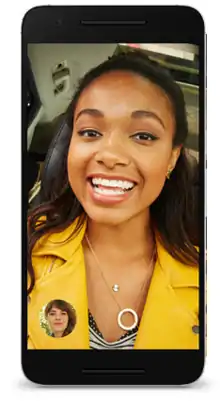Google Duo
Google Duo is a video chat mobile app developed by Google, available on the Android and iOS operating systems. It was announced at Google's developer conference on May 18, 2016, and began its worldwide release on August 16, 2016. It is also available to use via Google's Chrome web browser on desktop and laptop computers.
 A screenshot of Duo | |||||
| Developer(s) | Google LLC | ||||
|---|---|---|---|---|---|
| Initial release | August 16, 2016 | ||||
| Stable release(s) [±] | |||||
| |||||
| Operating system | |||||
| Available in | English | ||||
| Type | Video chat mobile app | ||||
| Website | duo | ||||
Google Duo lets users make video calls in high definition. It is optimized for low-bandwidth networks. End-to-end encryption is enabled by default. Duo is based on phone numbers, allowing users to call someone from their contact list. The app automatically switches between Wi-Fi and cellular networks. A "Knock Knock" feature lets users see a live preview of the caller before answering. An update in April 2017 lets users worldwide make audio-only calls.
As of December 1, 2016, Google Duo replaced Hangouts within the suite of Google apps device manufacturers must install in order to gain access to the Google Play Store, with Hangouts instead becoming optional.[1]
In August 2020, it was reported that Google was planning to eventually replace Google Duo with Google Meet, but would continue to support Duo and "invest in building new features" in the long term.[2]
Features
Google Duo video calls are in 720p HD video.[3] It is optimized for low-bandwidth mobile networks through WebRTC and uses QUIC over UDP. Optimization is further achieved through the degradation of video quality through monitoring network quality.[4] "Knock Knock" shows a live preview of the caller before the recipient picks up, which Google says is to "make calls feel more like an invitation rather than an interruption".[5] End-to-end encryption is enabled by default.[3] Duo is based on phone numbers, allowing users to call people from their contact list.[3] The app automatically switches between Wi-Fi and cellular networks.[3] For packet loss concealment Duo uses WaveNetEQ, a generative model based on DeepMind/Google AI’s WaveRNN.[6]
In March 2017, it was announced that Google Duo would let users make audio-only calls. The feature was first launched in Brazil,[7][8][9] with a global rollout in April.[10]
A year later in March 2018, video and voice messages were added to Duo. Users can leave messages up to 30 seconds long for contacts who are unavailable. These messages can then be viewed by the other party, with the option of calling afterwards.[11]
Support for eight-person video calls in both the iOS and Android versions of the app was added in May 2019.[12] In line with similar group calling offerings from FaceTime, WhatsApp, Skype and Facebook Messenger, participants can join or leave the conversation at any time.
Google Duo expanded group sizes from 8 to 12 at the end of March 2020 and has announced plans to increase the limit to 32 callers.[13][14]
See also
References
- Ruddock, David (October 7, 2016). "Google is demoting Hangouts to "optional" in the Google Apps package for Android, to be replaced by Duo". Android Police. Retrieved October 20, 2016.
- Lee, Abner (August 14, 2020). "Sources: Google plans to eventually replace Duo with Meet". 9to5Google. Retrieved October 22, 2016.
- Fulay, Amit; Adan, Yariv (May 18, 2016). "Saying 👋 to Allo and Duo: new apps for smart messaging and video calling". The Keyword Google Blog. Retrieved January 9, 2017.
- Bohn, Dieter (May 18, 2016). "Google Duo makes mobile video calls fast and simple". The Verge. Vox Media. Retrieved October 21, 2016.
- Uberti, Justin (August 16, 2016). "Meet Google Duo, a simple 1-to-1 video calling app for everyone". The Keyword Google Blog. Retrieved January 9, 2017.
- "Improving Audio Quality in Duo with WaveNetEQ". Google AI Blog. Retrieved April 1, 2020.
- Queiroz, Mario (March 22, 2017). "Google for Brazil: Building a more inclusive internet for everyone, everywhere". The Keyword Google Blog. Retrieved March 22, 2017.
- Erlick, Nikki (March 22, 2017). "Google announces app updates to Allo, Duo, and Photos". The Verge. Vox Media. Retrieved March 22, 2017.
- Palmer, Jordan (March 22, 2017). "Google Duo is finally getting an audio-only call option, rolling out first in Brazil [APK Download]". Android Police. Retrieved March 23, 2017.
- Vincent, James (April 10, 2017). "Google Duo's voice calls are now available worldwide". The Verge. Vox Media. Retrieved April 10, 2017.
- Lindsay, Dave (March 7, 2018). "Miss a call—but not the moment—with video messages on Google Duo". The Keyword Google Blog. Retrieved March 15, 2018.
- @juberti (May 23, 2019). "#GoogleDuo group calling is now fully deployed, with the simplicity, quality, and security you expect from Duo" (Tweet) – via Twitter.
- "Google Duo brings group calling with up to 32 people to web and adds family mode". Zee Entertainment. May 11, 2020. Retrieved May 12, 2020.
- Br; May 12, on Vigliarolo in Software on; 2020; Pst, 9:17 Am. "Google steps up Zoom competition by adding 32-person calls to Duo". TechRepublic. Retrieved May 15, 2020.CS1 maint: numeric names: authors list (link)